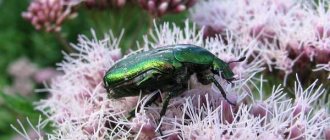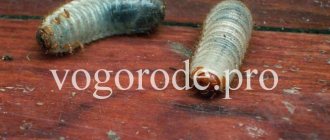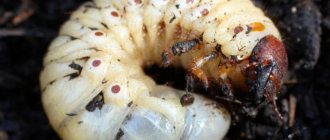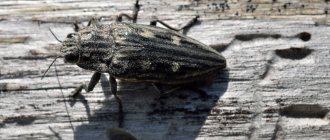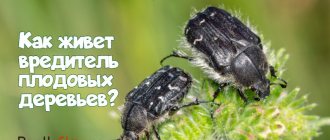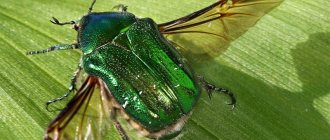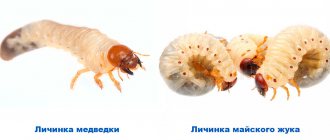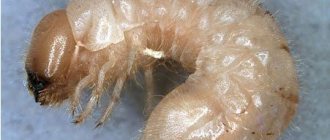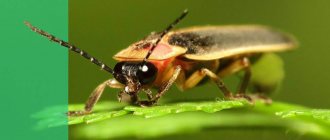A beautiful, golden, shiny, large beetle, even until recently (when there were very few of it) caused delight among flower growers.
But the population of the golden bronze was growing rapidly and the farmers realized that another disaster was approaching.
It is still believed that this species, unlike the hairy bronze, is not so terrible. The beetle comes out of hibernation late. By this time, the trees, as a rule, have faded. However, many crops are still in the flowering phase. Flower growers are also in panic; the beetle eats everything. How to deal with bronze grass, which eats the flowers of all the green spaces on the estate? Let's figure it out.
What does the bronze beetle look like: photo
Bronzovka: photo of a beetle.
Morphological characteristics of an insect
The bronze beetle has a bright greenish color with a metallic sheen.
That is, the insect is very beautiful. The body length of this beetle is about 2 cm. It is very active on warm days. The insect has wings, thanks to which it can move long distances. A peculiarity of beetles is that during flight they practically do not raise their elytra. For reproduction, females lay white-yellow eggs. They can be found in tree stumps or trunks that are almost rotten, in manure.
It takes about 12 months for the egg to hatch and reach maturity. There are several types of this pest: hairy bronze beetle, black beetle, and golden beetle. Most often, the body color of this pest is dark. However, it shimmers in the sun and visually changes color. The bronze beetle can cause enormous harm to plants. You will find out further how exactly the insect lives.
Description of the bronze beetle
Name: Bronzovki Lat.:
CetoniinaeClass: Insects - Insecta Order: Coleoptera - Coleoptera Family: Plasmine - Scarabaeidae
| Habitats: | vegetable garden and fields |
| Dangerous for: | plants of the cruciferous family |
| Means of destruction: | naphthalene, Aktara, Decis, mechanical |
Bronze beetle.
Bronzovka or bronzovik is part of the Coleoptera family. There are more than 5 varieties of this insect. The body has an oval shape. The size varies between 1.3 – 2.3 cm. The body length is affected by the type of beetle. Forelegs of digging type.
The color of the beetle looks emerald. However, the body is black. The chitin coating refracts light and makes it emerald metallic. In some cases, the tint may be copper-red or bluish. This is optical or structural pigmentation.
The design of the wings differs from other relatives. During flight, the elytra are slightly raised. The wings are produced thanks to special cutouts in the elytra.
The bronze beetle is often confused with the green cockchafer. But they have completely different lifestyles.
Habitat
Bronze on flowers.
The insect lives in Eurasia. Bronzovka can be found in any country on the continent. The exceptions are deserts and mountainous regions. They usually settle on flowers and bushes.
They are independent, but peaceful in nature. They can exist in several individuals in one area and even feed on one flower.
Life cycle
Golden bronze.
Sunny, warm weather stimulates the activity of the bronco. Beetles tend to move from one plant to another. Sometimes they can crash into people or animals.
Activity begins at the end of May and lasts about 4.5 months. This is influenced by the region of residence. In bad weather, the beetle sits motionless. When it gets cold, it leaves the flower and lives in the ground near the roots and stems.
In June, females lay eggs in the ground. The eggs are yellowish-white. Masonry is possible in an anthill, black soil, and dung heaps. After the laying process is completed, the females die.
Bronze beetle larva.
After 14 days, white larvae appear. The larvae's diet consists of plant remains and dead roots. The larvae grow up to 6 cm. After 2 molts, the body becomes yellow.
Ants are indifferent to larvae. Therefore, in winter they normally live together in an anthill. Beetles pupate in the spring. By June they become adults. In summer and autumn they eat plants and flowers. They become sexually mature by the next season.
Diet of the bronze beetle
The beetle prefers flowers and soft ovaries. It can also feed on juicy soft fruits, young shoots, and leaves. Bronzovka settles in the middle of the flower and destroys the stamens and pistils.
It is worth noting the aesthetic tastes of the bronze. First of all, the beetles choose graceful white and light pink flowers, and after them they can eat the rest.
Larvae comparison.
After this, the flowers wither and dry up. They have no core. Brown spots and damaged petals appear on adult plants. There is no green blade on the leaves.
Bronze beetle larvae are often confused with Khrushchev and May beetle larvae. But they only look almost identical in appearance. In fact, bronze fly larvae do no harm. They feed on dead organic matter.
Biological features
There are many bronzes. The family has more than 4 thousand species.
The most common in mid-latitudes are:
- golden;
- shaggy (shaggy deer);
- marble;
- Shamilya;
- Smelly;
- Goliath.
All pests belong to:
- class - insects;
- order - Coleoptera (beetles).
Golden bronze is common in areas where there are trees and shrubs. Residents of steppe regions may not even be aware of the misfortune. However, where there are ravine forests (trees growing on the slopes of ravines and ravines), it has found its place of residence in the south.
Methods of combating the bronze beetle
Are you afraid of bugs?
Not really
The bronze beetle is relatively harmful to agriculture, so no special methods have been developed to combat it directly.
You can attract a natural enemy - the Scolia wasp. Female wasps are immobilized while laying eggs. Wasp larvae feed on bronze beetle larvae.
One of the most common is the mechanical method. Early in the morning, beetles are collected from flowers by hand. Insects are placed in a jar with kerosene.
Chemicals
Chemicals are used in extreme cases. If the insect multiplies significantly, insecticides can be used carefully.
They use drugs that poison the Colorado potato beetle.
Spray the soil or introduce medications by watering. Treatment is carried out after sunset for the drug to start working. Apply:
- Decis;
- Spark;
- Lightning;
- Kinmiks.
Traditional methods
Among folk remedies, infusions with onions, horseradish, garlic, wormwood, tansy, and dandelion give good results. The following mixtures are particularly effective:
- horse celandine (300 g) is added to 1 liter of hot water. Leave for 2 days and spray, adding a teaspoon of grated soap;
- horse sorrel roots (30 g) are mixed with 1 liter of hot water and left for 4 hours. This solution is treated once every 5 days;
- wood ash is mixed with 5 liters of water and left for 48 hours. Add 1 tbsp. spoon of soap and spray.
Enemies
Bronzewort is part of the lunch of many birds, such as:
- magpies;
- jackdaws;
- rooks;
- rollers;
- jays;
- orioles.
Hymenoptera also contribute to the fight against bronze fly. For example, Scolia fourspot and steppe stinger inject paralytic poison into the beetle larva and immediately lay their larva. In this case, the larva of the bronze is a “canteen” for Scolia.
The tachine fly lays eggs in the soil, and the hatched fly larva infects the beetle larva. It also feeds on the bronco's body.
Types of bronze beetles
There are several varieties of the bronze beetle. Among them there are especially interesting and unusual ones that are rare.
What a lifestyle
The bronze dog leads an active lifestyle only during the daytime. The insect loves sunny heated areas. The drier the weather, the more comfortable the beetle. The representative is massive and prefers to move around as little as possible.
Often the beetle collides with other objects. After falling on its back, the insect often dies under human feet. To restore balance, the bronzefish needs to flounder in the dust for a long time.
We invite you to familiarize yourself with the Features of pain in the heart area (cardialgia): what could it be and what to do?
The beetle spends its energy sparingly. Selects plants where you can stay for as long as possible to minimize movement. In cloudy weather they do not leave the shelter.
At night they are localized on the ground. They also overwinter in the ground. Years last 3 months, less often – 4.
LiveInternetLiveInternet
–Categories
- cottage (109)
- vegetables (21)
- pests, diseases (15)
- flowers (14)
- do it yourself (12)
- berries (11)
- soil, acidity, fertilizers, lawn (8)
- construction (7)
- medicinal plants, herbs (7)
- books, TV (4)
- inventory, furniture (4)
- for home (83)
- kitchen (20)
- ideas (11)
- repair (8)
- children's (6)
- bath (4)
- living room (3)
- textiles (3)
- office, place (2)
- bedroom (2)
- balcony (2)
- wardrobe (1)
- cooking (79)
- baked goods (28)
- winter preparations (25)
- snacks, salads, sandwiches (5)
- seasonings (4)
- drinks (3)
- fish (2)
- unusual (61)
- crafts, needlework (47)
- TV series (47)
- documentary (39)
- library (38)
- cooking (5)
- for diary (34)
- take care of your health (31)
- hair (6)
- astronomy (29)
- history of Russia (26)
- knitting (23)
- children (23)
- cities and countries. (23)
- Samara (10)
- music (21)
- History (17)
- painting (16)
- flora,fauna (13)
- chemistry (11)
- holidays (8)
- poetry (8)
- food (6)
- legends, myths (6)
- auto (5)
- ZhZL (4)
- games (2)
- repair (1)
- Sergey Grishunov (1)
- performances (1)
-Music
–Search by diary
–Subscription by e-mail
– Regular readers
–Communities
-Statistics
Blue bowl, or traps for hairy Alenka
Practicing gardeners have noticed the fact that individuals of the Alenka hairy bronze beetle are attracted to the blue color. As paradoxical as it may sound, after leaving a blue rag on a branch, after a while, you can find several individuals of the bronze beetle on it. Therefore, they decided to use blue color in the form of traps. It is recommended to use blue and light blue bowls and buckets. In the absence of such, you can use blue, construction, medical, industrial. The main thing is that the solution does not have any foreign odor. Five-liter plastic bottles are cut into two parts. Pour water with the addition of blue into each container, stir, and place the containers with the resulting solution in all places on the site, close to flowering trees and shrubs or directly under them. Such a container will not attract bees, but the hairy Alenka will be collected as much as possible in a short period of time.
Of course, the methods listed are not always effective. A drug that completely destroys hairy Alenka and does not harm bees and bumblebees has not yet been developed, but it is simply necessary to fight the insect pest.
Read: How to fight a mole
Join our Facebook group
Where do they spend the winter?
Bronze beetles overwinter in heaps of humus, as well as in anthills. That is why many forest animals (foxes, badgers and others) dig anthills in winter in search of delicious high-calorie larvae. By the way, the larvae themselves are absolutely harmless to the garden and even do useful work, effectively processing the substrate.
Development from egg to adult
For laying eggs, the bronze moth chooses loose substances: compost heaps, rotten wood and stumps, anthills. Soon they hatch into larvae, which eventually reach a length of up to
5 cm. For the future population, it is important that the temperature regime is optimal; with a strong deviation in one direction or the other, either only females or only males will emerge from the cocoons.
The larvae have a thick white body and six short, weak legs. They feed on rotten parts of plants. The digested remains perfectly fertilize the soil, and voracious creatures serve as a good source of natural black soil. The larvae are perfectly adapted to underground life, but become helpless once on the surface. Their weak legs are unable to move their heavy body, and they have to move on their backs, sharply contracting their strong muscles.
To transform into a pupa, the larva collects pieces of leaves and rotten wood, combines them with sticky secretions of its body and builds a cocoon in which transformation into an adult will take place. The adult insect overwinters in the ground and comes out into the air in the spring.
